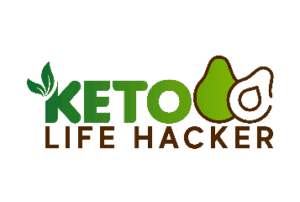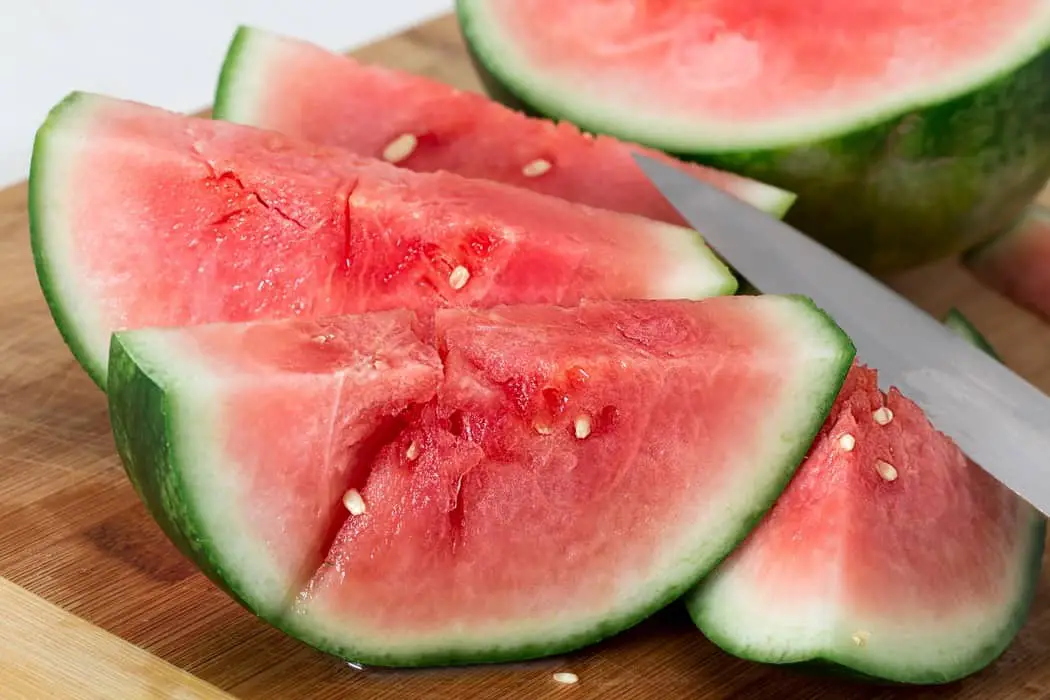One of the most challenging aspects of the keto diet when I first started out was figuring out which fruits and vegetables I was allowed to eat.
I encountered so many conflicting sources, and I wasn’t really sure where to turn. There’s a ton of fruits out there that are way too high in natural sugars for keto, but there are a few that can still be enjoyed in small quantities on a low carb diet.
In this article I’ll be doing a deep dive on watermelon, and will get to the bottom of just how keto-friendly it actually is.
Nutrition Breakdown of Watermelon
The nutrient breakdown of one serving of watermelon (one cup, or 152 grams) is as follows:
- Total Calories – 43 kcals
- Total Fat – 0 grams
- Total Carbohydrates – 11 grams
- 9 grams of sugar
- 1 gram of dietary fiber
- Total Protein – 0 grams
- Sodium – 2 milligrams
- Vitamin A – 17% of Recommended Daily Value
- Vitamin C – 21% of Recommended Daily Value
- 2% of iron
- 1% of calcium
Watermelon is also an excellent source of key nutrients and electrolytes such as thiamine, riboflavin, vitamin B-6, folate, copper, manganese, potassium, zinc, magnesium, selenium, choline, betaine, and lycopene.
In fact, watermelon contains more lycopene than any other fruit or vegetable.
Lycopene is important for our diets because of its strong antioxidant properties, which have been known to reverse some adverse effects of aging, and inhibit and prevent the growth free radicals and cancer cells within the bodies.
From here, lets get into some other concrete benefits of watermelon as a food.
Benefits of Watermelon
-
Helps you stay hydrated
As its name suggests, watermelon is jam packed with, you guessed it, water. In fact, it’s 92% water, technically.
A benefit of this is an increased likelihood of staying hydrated, which can lead to reduced hunger, feeling fuller for longer periods of time, and improved digestion.
-
May lower inflammation
Inflammation is a primary driver behind a variety of certain types of chronic diseases, and is one of the main things that you should avoid in order to maintain a state of ketosis when following a keto diet.
Watermelon has been found to lower both inflammation and oxidative damage from excess inflammation, because of its antioxidants known as lycopene and vitamin C.
Another big benefit of these antioxidants is the benefits that they can provide to brain health. One recent study found that increased consumption of foods high in antioxidants may be able to delay the onset and progression of Alzheimer’s disease.
-
May improve heart health
Heart disease is the number one cause of death throughout the entire world, which is why its vital to stock up on heart healthy foods when possible.
Eating certain types of foods that are deemed to have heart healthy properties may be able to lower your overall risk of developing a heart or stroke, by directly reducing your cholesterol and blood pressure levels.
When it comes to watermelon, there are a few key nutrients that have shown direct benefits to heart health. Lycopene remains the largest one because of its antioxidant properties, and ability to reduce inflammation.
Downsides of Watermelon
-
High in sugar
Unfortunately, one of the biggest downsides of watermelon is that it’s fairly high in sugar, despite its fiber content.
Along with being high in sugar content, it also has a significantly high glycemic index value, which means it can lead to dramatic spikes in blood glucose levels.
-
Can lead to too much lycopene consumption
Because watermelon has so much more lycopene than other fruits, if you eat too much of it, it’s possible that you could actually consume too much lycopene, which can have some adverse side effects and health risks.
Eating too much lycopene can lead to complications of the GI tract, including nausea, indigestion, and cramps and bloating. It is also one of the driving factors that contributes to spiking those blood glucose levels if consumed in too large of quantities.
-
Can lead to too much potassium consumption
While potassium is generally seen as an important electrolyte, consuming too much of it can lead to some pretty big complications.
Having too much potassium in your blood is commonly referred to as the condition Hyperkalemia. This takes place largely when your kidneys are unable to remove potassium from the body quickly enough.
While eating lots of potassium usually doesn’t cause this, it is possible to speed up the development of hyperkalemia with consistent overconsumption of potassium. Symptoms of hyperkalemia include abnormal heartbeat, general weakness, ad light headedness.
Is Watermelon Keto-Friendly?
As you can see, based on Watermelon’s high sugar (and net carb) content, as well as its high glycemic index value, it isn’t exactly keto-friendly.
Granted, it can be eaten in moderation, when paired with enough low carb and high fat foods, but it generally should be avoided compared to other fruits when following the keto diet.
Other fruits that are a bit more keto-friendly include:
-
- Strawberries
- Blueberries
- Blackberries
- Raspberries
- Blueberries
If you came here looking for keto-friendly watermelon recipes, unfortunately none exist because they’d all either not be watermelon-based, or would be too high in carbohydrates.
However, I’ve laid out some of my favorite keto-friendly fruit recipes below, which should be able to help you manage those sweet fruit cravings.
Keto-Friendly Watermelon Alternative Recipes
-
Strawberry Chia Pudding with Almond Milk
Ingredients:
-
- 2 cups of unsweetened almond milk
- 1/3 cup of chia seeds
- 1/8 teaspoon of vanilla stevia drops
- 1/8 teaspoon of liquid monk extract
- 1 tablespoon of lemon juice
- 1 cup of fresh or frozen strawberries, chopped
Instructions:
-
- In a medium bowl, stir together the chia seeds into the almond milk
- Add in the stevia sweetener as well as the monk fruit sweetener, lemon juice, and strawberries
- Mix all of the ingredients well
- Stir every 5 minutes for the next 15 minutes
- Divide the mixture into serving dishes and chill for at least 4 hours, or overnight
- Serve chilled with a spoon
-
Jicama Apple Pastry Filling
Ingredients:
-
- 4 cups of jicama chopped
- 2 teaspoons of apple extract
- 1/2 cup of swerve (erythritol)
- 1/2 cup of kerrygold butter
- 1/4 teaspoon of nutmeg
- 1 teaspoon vanilla extract
- 1/8 teaspoon of cloves
- 1 tablespoon of cinnamon
Instructions:
-
- Combine the chopped jicama together with the butter, swerve, and spices in a pan
- Cook and stir the contents of the pan over medium heat until the jicama has started to soften
- At the end of the cooking, stir in the vanilla and apple extracts
- Serve warm
- This dish can be refrigerated for up to one week, and can be kept frozen for several months after cooking
-
Low Carb Blueberry Cobbler
Ingredients:
-
- 3 cups of fresh blueberries (frozen works too)
- 6 tablespoons of melted kerrygold butter
- 1 whole egg, beaten
- 2/3 cup of almond flour
- 1/3 cup of coconut flour
- 1/4 cup of swerve
- 1/4 teaspoon of xanthan gum
Instructions:
-
- Pour the berries into a greased 9×9 inch baking pan
- Sprinkle the berries with lemon juice and xanthan gum.
- If desired, add in an additional two to four tablespoons of your swerve sweetener to the blueberry mixture for desired level of sweetness
- Stir the almond flour, coconut flour, a quarter cup of your swerve, and the beaten egg until the mixture resembles that of coarse meal
- Sprinkle dry mixture on top of the berries
- Drizzle melted butter all over the topping
- Bake the tray at 350 degrees F for roughly 25 minutes, or until the top of the dish has started to brown
- Serve warm, and enjoy
-
Keto Lemon Bars
Ingredients:
-
- Half a cup of melted butter
- 1 cup of powdered erythritol
- 3/4 cups of almond flour
- 3 large eggs
- 3 medium sized lemons
Instructions:
-
- Mix the butter, cup of almond flour, erythritol with a pinch of salt
- Press the mixture evenly into an 8×8 inch baking dish lined with parchment paper
- Bake the dish for 20 minutes at about 350 degrees F
- Let cool for 10 minutes
- Separately, in a bowl, zest one of the lemons, then juice all three of the lemons
- Add in the eggs, a third cup of erythritol, a third cup of almond flour, and another pinch of salt to the bowl
- Combine to make the filling
- Pour the filling onto the crust and bake for an additional 25 minutes at 350 degrees F
- Serve with lemon slices and a sprinkle of powdered erythritol for topping
-
Strawberry Cheesecake Fat Bombs
Ingredients:
-
- Half a cup of strawberries, fresh or frozen
- 3/4 cup of cream cheese, softened
- 2 tablespoons of powdered erythritol, or 10 to 15 drops of liquid stevia
- 1 tablespoon of vanilla extract
- 1/4 cup of coconut oil
Instructions:
-
- Place the cream cheese and coconut oil into small pieces in a mixing bowl
- Leave the bowl at room temperature for about 30 to 60 minutes until it has softened
- Wash the strawberries and remove the green parts
- Place the strawberries into a bowl and mash with a fork or place in a blender for smooth texture
- Add in the powdered erythritol or drops of stevia, along with the vanilla extract, and mix well
- Add in the strawberries at room temperature, and add the whole mixture to the bowl with cream cheese and coconut oil
- Use a food processor and mix everything until well combined
- Spoon the entire mixture into fat bomb molds, place in the freezer for roughly 2 hours or until it is set
- When finished, take the fat bombs out of the molds and place into a container
- Keep fresh in the freezer, and consume whenever you’d like


